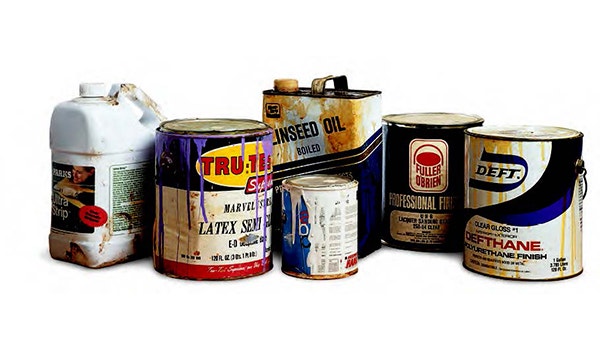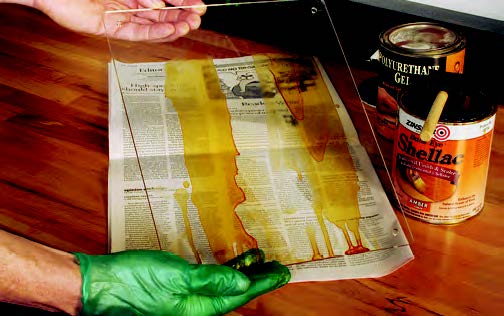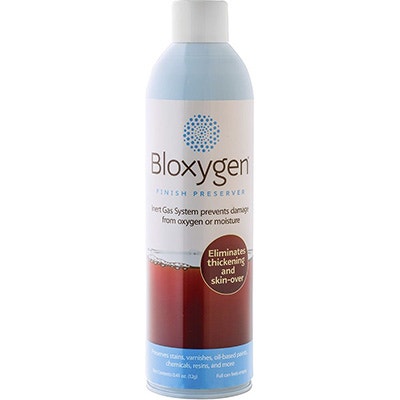How to Determine If Stored Finishes Are Still Good

Spring cleaning? It’s time to check your stock of finishes to decide what is still usable and how to safely and legally dispose of what isn’t. It’s also a good time to go over the best ways to store finish for long life.
Shelf Life
Buy milk, and it will have a clearly printed “use by” or “sell by” date on it. Unfortunately, most paints and clear coatings don’t.
Manufacturers of oil-, water and solvent-based coatings suggest a three-year shelf life for liquids or aerosol cans. The exception is pre-cat lacquer, which comes with a specific “use by” date. It won’t appear different when it goes bad, so be conscientious about those usage dates.

Three years is a safe number, but the truth is that older coatings, properly stored, may be viable much longer, though shelf life varies from one finish to another.
Nitrocellulose lacquer can last indefinitely, and even decades-old lacquer is usually just fine. The same is true of catalyzed lacquer or conversion varnish, provided both the catalyst and lacquer base are properly sealed and stored separately. However, if the catalyst is exposed to air, it could quickly lose its strength.
Gloss oil-based varnish, polyurethane and Danish oil can last 10 or 20 years, though satin finishes and stains may fail sooner as pigments and flattening agents disable the driers. Water-based coatings and paints can also be viable longer than three years. Shellac, though, can go bad in under a year. An exception is Zinsser SealCoat™, a dewaxed shellac made of special long life resin that can last five years or more.
A Better Way to Tell
To tell if it is still good, start with a visual inspection. Discard finishes that have become thick, rubbery, stringy or separated, as well as those with a skunky odor or obvious mold growth. Ditto for water-based paint or finish that looks like cottage cheese.
If the color, viscosity and smell are right, do a drying test. Place some finish on a piece of glass or plastic laminate, tip it at a 45 degree angle to allow it to flow, and see how fast it dries. Oil-based finishes should dry hard overnight, water-based in less than six hours, and shellac or lacquer in under an hour.
With everything except precat lacquers, if the finish looks, smells and dries as it should, it is probably safe to use no matter how old it is.
Extending Shelf Life
As with food, storage conditions matter. Coatings should be stored in a dry area with temperatures between 50 and 75 degrees F (10 to 24° C). They must also be well-sealed. A good seal prevents air, moisture and bacteria from getting in and solvent from evaporating out.
On round cans, make sure the rim is clean and the seal is airtight. Wipe screw cap spouts on square cans, like Danish oil, before closing, and drape wax paper, plastic wrap or a thin vinyl glove between cap and spout to make a better seal. Squeeze the can; if air exhales, you don’t have a good seal.
Even if tightly sealed, oil-based coatings, which cure by reacting with oxygen, can crust or harden due to the air in a half-used can. Usually, you can discard the crust and use the finish below. Some folks pump in propane, which is flammable, add marbles to raise the liquid level or place a sheet of plastic wrap on top as an air block, both of which are messy, or store the can upside-down, which allows the rust to grow from the bottom instead of the top.
The best choice, though, is to prevent in-can curing by removing the oxygen, and the easiest way to do that is with Bloxygen®. A can of Bloxygen feels empty when you buy it, but don’t let that fool you. Spray it into the can before you seal the lid, and it will chase out the oxygen and replace it with inert argon, which will prevent varnish crusting, thickening or solidifying.

Throwing it Out
The EPA estimates that 10 percent of the house paint purchased in the U.S. each year, about 65 million gallons, is ultimately discarded. In spite of that, disposing of finish, called “household hazardous waste,” varies from one county to another.
Of course, you can always let unused finish dry. Brush or spray finish onto cardboard or scrap wood, or mix it with kitty litter spread out to dry. Once the finish is dry and solid, it is landfill safe and can go out with the household trash.
Keep the inspiration coming!
Subscribe to our newsletter for more woodworking tips and tricks






